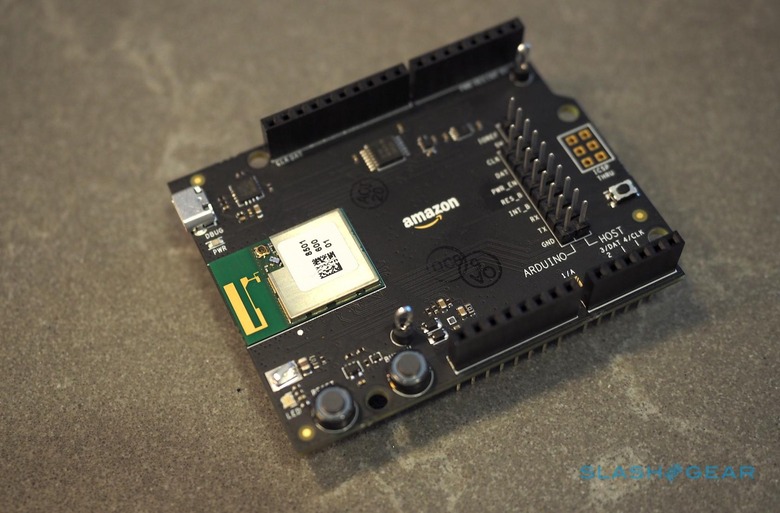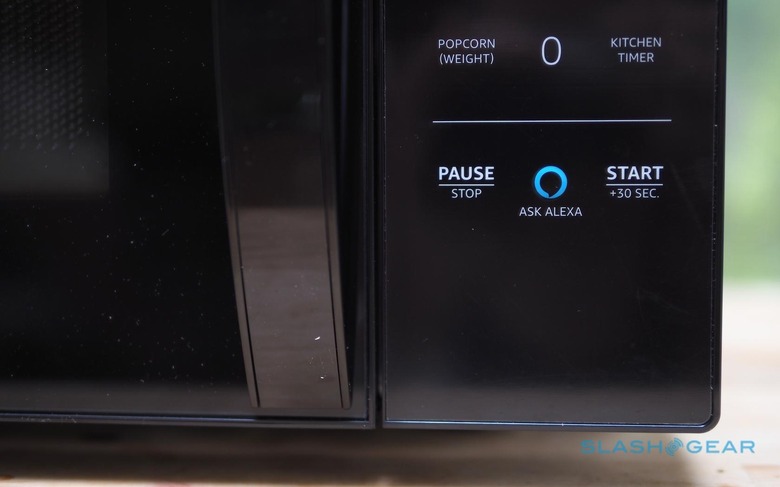The Amazon Smart Microwave Is An Alexa Trojan Horse
Kitchen conversations usually consist of "what time is dinner ready?" and "it's your turn to load the dishwasher," but Amazon's Alexa-powered microwave hopes to change all that. It's easy to joke at the idea of a voice-controlled appliance, certainly one which counts proactively reordering popcorn among its key talents, but the AmazonBasics Microwave is more important than you might think. For $60, it's Amazon's cunning Trojan horse for Alexa.
Why would I want to speak to my microwave?
Most of the time, we're only using a fraction of the capabilities microwaves offer. Even the cheapest typically have presets for reheating food, preparing different packaged meals, making popcorn, or cooking potatoes or vegetables. Problem is, few of us bother learning how to use those presets.
Instead, we just press the "add time" button and go by trial and error, hovering by the door and peering in through the window to try to catch what's inside before it spills over or burns. If you're a microwave manufacturer, then, you have a choice. Either you accept that nobody is using your presets and dump them – and probably have to accept a lower price for a more "simple" model as a result – or you make those presets easier to use.

Voice is one such way to achieve that. Sure, you still need to know what you're putting inside the AmazonBasics Microwave – eight ounces of vegetables, maybe, or a mug of cold coffee, or a couple of yams – but you don't have to remember the arcane combination of keypresses to make the preset work. Asking Alexa with a speech command can easily save half a dozen or more button-presses.
Why has Amazon made it so basic?
It's fair to say this Alexa-powered microwave is basic: after all, it's right there in the AmazonBasics branding. As kitchen appliances go, it's hardly going to stand out in a sea of custom-installed ovens and gleaming stainless steel gadgets. Then again, it's not really meant to.
Amazon's decision to make a basic model wasn't from lack of ambition, however. There's no reason why the Alexa Connect Kit couldn't tie into a microwave that can weigh your food and adjust its cook-times to suit, or support a more graphically-interesting display, or integrate grilling and baking features. That's down to individual manufacturers to decide.
What the AmazonBasics Microwave does, and why it exists, is to demonstrate that connected appliances needn't be the most expensive models on the market. At $59.99, it's right in the midst of non-connected microwaves of the same power and size. It's all about highlighting the potential – and affordability – of the Alexa Connect Kit.

What's the Alexa Connect Kit?
Unlike most Alexa-powered products, Amazon won't be selling the Alexa Connect Kit to individual customers. Instead, it's hoping to win over appliance-makers, who might be interested in making smart devices but who are dissuaded by the complexity.
Physically, it's a compact chipset that links via a serial connection to the electronics in its host device. It's responsible for getting the device online via WiFi and Bluetooth, as well as tapping into the various Alexa APIs and cloud services. Amazon's promise is that there won't be any subscription fees, and that it will handle security and feature updates and patches for the lifetime of the device.

If you're a company that specializes in kitchen appliances, that might be a tempting deal. After all, it means you don't have to arrange your own software and apps; it frees you from needing to consider data security; and it instantly taps into a large – and growing – smart home ecosystem. Best of all, it's relatively affordable. Amazon isn't talking specifics, and the price of the Alexa Connect Kit will depending on order size and other factors. However, it's in the region of the cost of a cup of coffee.
So my microwave can talk, what next?
Think of the AmazonBasics Microwave as a reference design, much in the same way that Google used the early Nexus phones to lay out a preferred roadmap for smartphones to its hardware partners. We're yet to see any announced devices from third-parties, though Amazon says big names like Hamilton Beach and Procter & Gamble are already onboard. Still, it's not hard to think of some possibilities.

An Alexa-powered oven, for example, could automatically set its temperature according to what you tell it you want to bake. Your Instant Pot electric pressure cooker could configure the time and other settings by what you ask it to cook, rather than forcing you to look up recipes online. You could bypass complex scheduling for thermostats, dehumidifiers, or air purifiers, by simply asking Alexa to run them until a certain time, or moisture level, or air quality.
Rather than spinning the dial on a washing machine and hoping you get the right program to avoid shrinking your sweaters, you could just tell Alexa what it is you're cleaning. Your dryer could do the same for your delicates, and dishwasher could handle fragile tableware or cookware with baked-on food more readily.
What if I have no interest in talking to appliances, ever?
Nobody is going to force you to hold a conversation with your washing machine, or engage in witty badinage with your coffee maker. While the Alexa Connect Kit might have Amazon's voice assistant in the name, it's not solely about enabling spoken interactions for every product in your home. There's plenty that connected devices can do that doesn't involve voice.
The AmazonBasics Microwave can set its own clock, and adjust it automatically when daylight saving time kicks in. Your washing machine could notify you – through Alexa's network – from the basement that it has finished, so that you don't leave wet clothes sitting inside, forgotten. Your home security alarm might send out status alerts that show up on your Echo Show smart display, or arrive as notifications on your phone. Blinds could close by voice, or automatically according to the changing sunset times of the season.

Lamps might track bulb life, and even reorder the correct replacement through Amazon's Dash Replenishment when they're about to expire. Your vacuum cleaner could do the same with its filter, or your range hood, or your furnace. A whole host of normally mundane products, that until now have operated in little silos of their own, could suddenly be able to intercommunicate.
Are those features worth several hundred dollars or more, for a top-of-the-line appliance that happens to have connectivity baked in? For most people, probably not. But if manufacturers follow Amazon's lead, and price their devices aggressively, it could be a significant tipping point in the Internet of Things, and the smart home specifically.
So what's the downside?
It's easy to get excited about a whole host of more affordable "smart" devices. All the same, there are legitimate concerns worth considering. For some, the fact that this is Amazon – a retail behemoth already giving people pause courtesy of its huge size, its role in squeezing out brick-and-mortar businesses, and factors like workers' rights – will be enough to turn them off.
The fact that it's Alexa-specific, too, has serious platform implications. It's fairly rare, currently, for a connected device to commit to one single IoT ecosystem. Usually, the selling point is that they'll work with Alexa, Google's Assistant, and maybe Apple's HomeKit too, along with whatever app the manufacturer itself is offering.
The Alexa Connect Kit, though, only works with Amazon's services, unsurprisingly. It leaves manufacturers with a decision – do they commit to Alexa as a platform, because Amazon's kit makes it so simple, or do they try to build in support for more platforms and face the complexity and expense that entails? – but also consumers. IoT lock-in is very real, and while Alexa seems unlikely to disappear in the same way that many smart home startups have over the past few years, it still limits your choice when it comes to potentially jumping ship to a rival ecosystem down the line.

If one thing is clear, it's that the IoT wars are nowhere near settled yet. Amazon and Google have been sparring most notably for some time, and we're yet to see what the latter might do to push back at the Alexa Connect Kit specifically. Apple, meanwhile, got off to a comparatively slow start, ironically through its demands that device-makers use its custom chipset for HomeKit. With the arrival of software compatibility for HomeKit, however, we're seeing a new pipeline of Apple-compatible products from manufacturers embracing an easier route.
Until the first third-party products using the Alexa Connect Kit arrive for sale, it's hard to say whether they'll sweep the market. After all, it's not just a product decision: it's also how they're positioned in terms of price on which their appeal will depend. Those who have already bought into Alexa as their ecosystem of choice have plenty to look forward to. For everybody else, it's wait-and-see time as Amazon and the rest wade into this next smart home skirmish.
